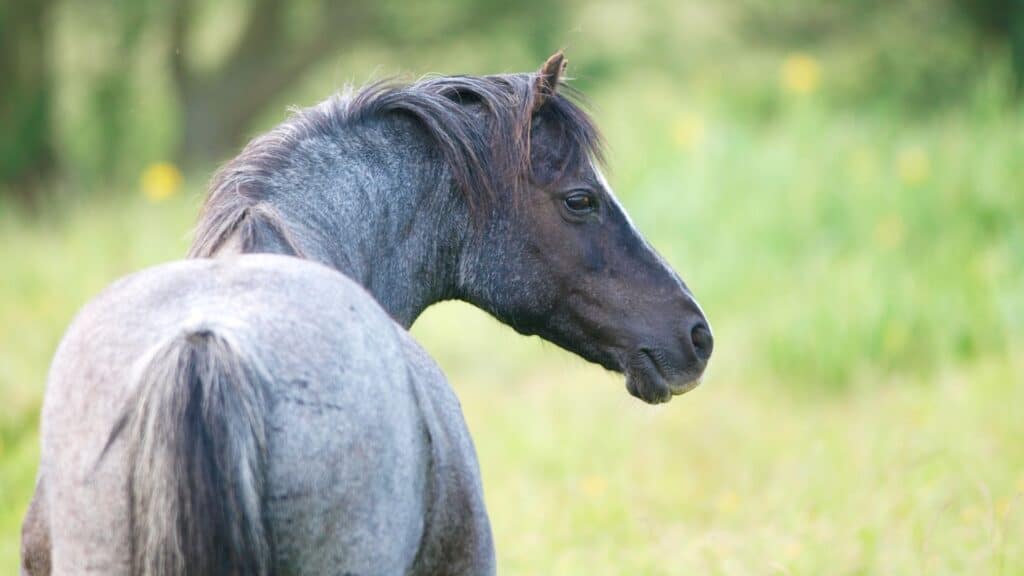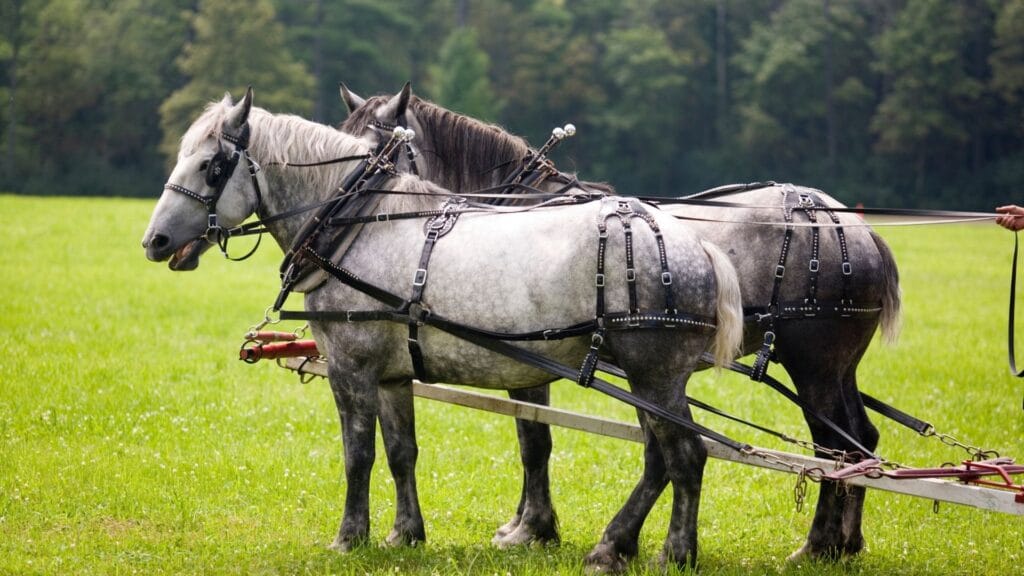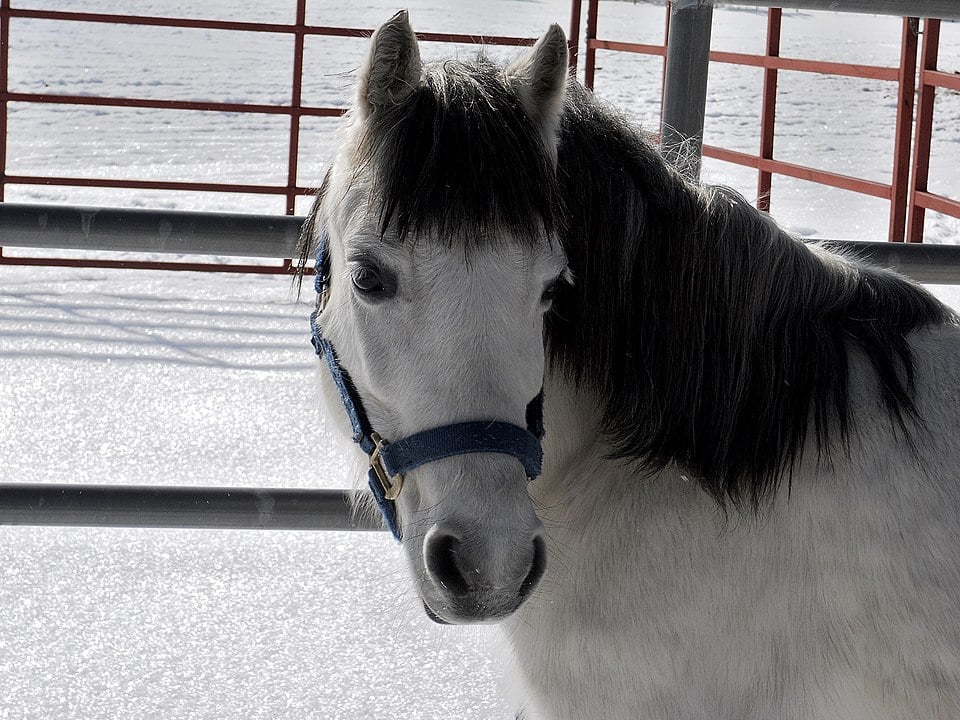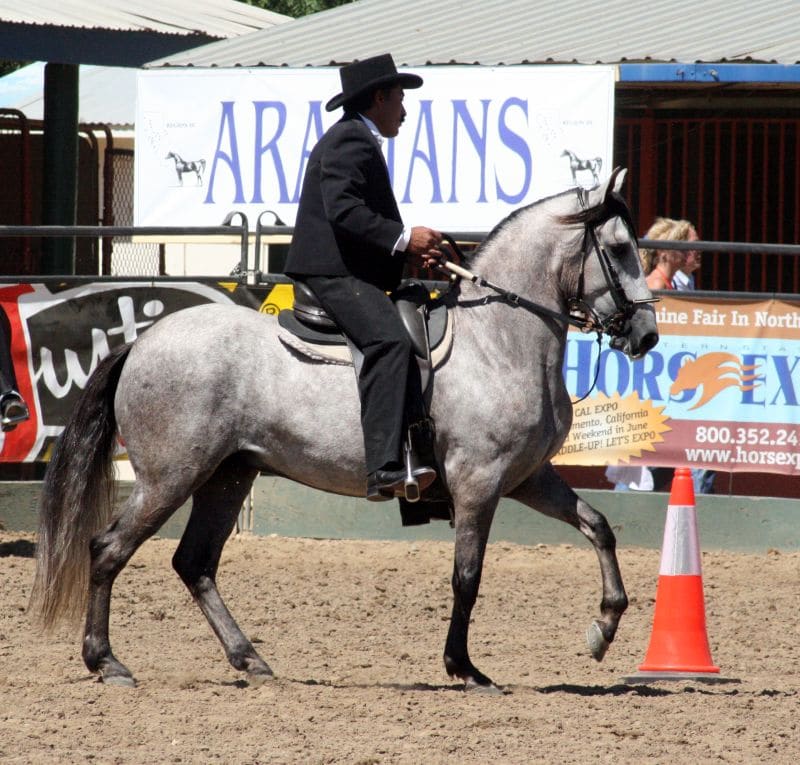Funny B Rojo Blue Quarter Horse Height
Any links on this page that lead to products on Amazon are affiliate links and I earn a commission if you make a purchase. Thanks in advance – I really appreciate it!
My neighbor just bought a five-month-old blue roan, so I decided to bring my grandson to see the colt. Afterward, he wanted to know all about blue roan horses, so I did some comprehensive research to provide all he could wish to know about this fascinating horse.
Blue roan horses have a color pattern with a relatively even mixture of black and white hair that creates a blue appearance. Their head and lower legs are typically darker and have little or no white. Blue roan horses are present in many equine breeds.
Many horse owners like horses with flashy coloring, and blue roan horses can be the most striking of equine coat patterns. However, there is a lot more to a blue roan than its color.

What horse breeds have blue roans?
Blue roan is a horse coat color made up of a mixture of black and white hairs, giving the horse an overall blue appearance. However, blue roan is not actually a color itself, but rather a pattern that can occur in many different horse breeds.
Some of the most popular horse breeds that have blue roan coats include the American Quarter Horse, Thoroughbred, and Arabians. Blue roan is a relatively rare coat color, so these horses are often considered quite valuable.
However, some horses with grey color patterns resemble roans but are not. I've seen a few Thoroughbreds that look like blue roans, but they are genetically different.
The distinction is difficult to comprehend, but when I consider how humans inherit traits that are detectable through DNA it makes it more understandable. For example, I look Spanish, but DNA testing and analysis show I'm 100 percent, Irish.
It's the same with horses; just because a horse resembles a roan doesn't mean it is. Also, some brindle horses look like roans but have an entirely different genetic pattern.
Most draft horse breeds, pony breeds, and many equine breeds originating in North America possess the roan gene. These include the American Quarter horse, Percheron, Belgian, Welsh pony, American Paint Horse, and Paso Fino.
In addition to their striking appearance, blue roan horses are also known for their calm temperament and intelligence. As a result, they make excellent riding and working partners.

American Quarterhorse
The American Quarter Horse Association accepts seventeen colors for registration, and among the acceptable colors is blue roan. The blue roan my neighbor recently purchased is a registered American Quarter horse.
The American Quarter Horse evolved from numerous horse breeds, including Thoroughbreds, Percherons, Belgians, and wild mustangs in the western United States. They originally were bred for racing short distances in the early colonies over 200 years ago.
Today's Quarter horse is a versatile and athletic breed that participates in many equine events. The American Quarter Horse Association has the largest number of registered horses in the world.
It's believed quarter horses acquired the roan gene through their European ancestors, including Belgians, Percherons, and Welsh ponies.

Percheron
Percherons are typically black or grey; however, they accept other colors, including blue, bay, red roans, chestnut, and bay. The Percheron Association of America was established in 1876 and set strict standards for the breed.
However, over the years, the rules for registrations have been amended and are more accepting.At its peak, the Percheron Association of America was the largest globally, registering over 10,000 horses annually.
Today the association registers approximately 2,500 horses per year. Percherons are a versatile draft horse breed originating from France. They are exceptional riding and draft horses. Like most draft breeds, Percherons horses have a calm demeanor, but they are also alert and willing workers.
They are powerful horses that typically stand between 15 and 16.3 hands tall. Percherons are renowned for their stamina and intelligence.

Belgian
In the United States, Belgian horses are typically bay or chestnut, with white markings on their face and legs. There are both blue and red roan Belgians in the U.S., but they are more prevalent in Europe.
Belgians are a large draft breed with a docile nature and amazing strength. They hold most of the equine world pulling records. They are typically 16 to 17 hands tall and average about 2,000 pounds.
The Belgian horse breed is a descendant of the Flemish "great horse." The "great horse" is the steed ridden by medieval knights in battle. The Flemish horse has influenced many draft breeds, including the Shire and Clydesdale.

Welsh pony
Welsh ponies can be red or blue roan and various other colors, including black, gray, bay, roan, cream, or chestnut but never piebald or skewbald.
Welsh ponies range in height from 11 to 14.2 hands. Besides their height range differences, Welsh ponies' coat density also varies greatly, some have thick wooly coats, and others are quite slick coated.
Because the animals vary so greatly, they are different classes within the breed. The categories are sorted by height and called referred to as either Welsh ponies or Welsh Cob horses.
The Welsh pony is an ancient breed that originated in the hills of Wales. They survived because of their versatility and hardiness. They've been used to pull chariots in sporting arenas, worked in coal mines, and used as a ranch pony.

American Paint Horse
The American Paint horse breed is typically white and other colors such as black, bay, palomino, chestnut, dun, or blue roan. However, the American Paint Horse Association allows some solid coat colors to register as "Solid Paint Bred."
There are three paint horse patterns distinguished, tobiano, overo, and tovero. A horse with a tobiano pattern typically has a solid colored head and color on its flanks and chest with white below its hocks on each leg.
A horse with the overo paint pattern has four dark legs and no white between its withers and tail. Most overos have a lot of white marking on their head and a solid colored tail.
The tobiano pattern features a combination of overo and tobiano. It typically has color on its flanks and dark color around its ears, with one or both eyes blue.

Paso Fino.
The Paso Fino Horse Association accepts all colors for registration, and the breed does possess the roan gene. But the most common colors are bay, chestnut, brown, and black.
Paso Fino horses are a naturally gaited breed that originated in Puerto Rico. They are a cross of many breeds including barb, and Andalusian. They are known for their smooth ride and incredible strength.
The breed has three distinctive strides; the fastest is the Paso Largo gait. When in this stride, the animal can travel 22 miles per hour and maintain a smooth pace.
Paso Finos are on the smaller size; they only average 14.1 hands tall but can carry heavy loads with ease.

What are some good names for blue roan horses?
Naming your new horse is fun. My friend's six-year-old daughter named their blue roan colt little blueberry. I think it's a fitting name, but maybe I would drop the "little" after the horse gets older and go with blueberry.
Top 10 names for blue roan horses:
Blue roan horses are often the best-looking horses; not only do they have cool color, but their speckled hair is unique and eye-catching. Because they're so good-looking, you want to choose a name that fits. So here are my suggestions:
- Blue
- Silver
- Steel
- Blue Steel
- Frosty
- Rain
- Storm
- Lightning
- Skye
- Breezy
Top 10 names for roan horses.
- Roany
- Rona
- Shadow
- Dusty
- Ghost
- Breeze
- Speckles
- Sprinkles
- Thunder
- Stardust
Top 10 names for red roan horses.
- Apricot
- Big Red
- Cayenne
- Pepper
- Dusty Rose
- Flame
- Gypsy Rose
- Raspberry
- Rosebud
- Spitfire
How do you get a blue roan horse?
To get a blue roan foal, you need to have one parent with black horse genes and have at least one parent that carries the roan gene. For example, when a black horse carries the roan gene, it can produce blue roan foals, but nothing is guaranteed.
The genetics behind the blue roan color pattern.
The study of genetics attempts to explain why and how individual living organisms inherit traits, characteristics, or structural features from their ancestors.
For example, horses are blue roans because they have inherited specific genes from their parents. Genetics is the investigation of the gene necessary to produce these traits.
Roan is symbolized by the Rn allele in genetics and is dominant, which masks the effect of a different variant on the same gene. The phenomenon of two different variants of the same gene on each chromosome is inherited in roans.
Roans can be homozygous, which means they carry two roan genes, and every foal they have is passed a roan gene. Homozygous roans can't be distinguished by their appearance but can be identified through the animals' DNA genotype.
An animal's genotype is its set of heritable genes that they pass from parents to offspring. The genotype Rn/Rn represents homozygous roan horses; roan animals with one dominant roan gene are genotype Rn/rn (heterozygous roans) and may or may not pass the roan gene.
These traits are essential to breeders because they can guarantee a roan offspring from a homozygous roan mare or stallion. However, genetics is complicated; for example, the mutation responsible for a true roan has not been precisely identified.
Some linkage to blue roan breeding has been found effective. Breeding roan and chestnut with specific gene sequences will produce a blue roan appearance.
The horse has to possess one chromosome with the non-chestnut allele and the dominant roan allele. The other chromosome carries the recessive chestnut allele and the recessive non-roan allele; this combination will appear blue roan.
A roan zygosity test is reliable in some equine breeds to identify true roan genotype. But there is still a lot to learn about the genetics behind roan animals. If you want to learn more about roan genotype testing, I suggest starting here at the UC Davis site.
Blue roan facts
As I earlier stated, blue roan horses have white hair intermixed with black hair to create the appearance of a blue coat color. But now, we will dive into roan horses a little deeper.
We'll trace the word's etymology, traits unique to roans, and some other fun facts about blue roan horses.
Etymology of roan
The word "roan" traces back to Middle French circa 1500. It was initially used to describe a reddish-brown color primarily about horses. It may be based on the Spanish word roano or raudano connected to Germanic rauos, meaning red.
King Henry VIII imported roan barbs and used the horses to develop the Thoroughbred. King Henry VII bringing the horses to England may have prompted Shakespeare's fascination with this equine color.
Because he seemed to have a special place in his heart for roan horse and actually rode a roan barb, a highly desired breed from North Africa. Shakespeare also included roans in his plays mounting King Henry II on a roan horse.
In the play, Richard II, act five, scene five, King Richard II is in prison when notified that Henry IV is now riding his roan in the procession for his crowning.
Shakespeare includes roan horses in many plays, and his use of the term popularized the horse and the descriptive term.
Roan horse definition
The modern use of roan is a reference to the coat color of animals. It typically refers to an even mix of white hairs with the animal's base color.
Roan animals also commonly have less white hair on their heads and lower legs. Some of the animals that display roan coloring are horses, cattle, antelope, and dogs.
Unique roan traits
Unlike greys that may be born dark and lighten as it ages, a roan exhibits its coloring at birth. A roan foal may lighten with the seasons, but otherwise, their coloring won't change as they grow older.
Interestingly I've noticed that the blue roan foals I've been around are born with red manes that turn black before they turn two years old. I'm unsure if this is common in all blue roan foals or unique to the ones I've seen.
Roans are typically either red roan, bay roan, or blue roan. A red roan has a chestnut base, blue roans a black base, and bay roans a bay base color. There are many variations of these primary roan colors.
If a roan horse gets a cut or scrapes its skin, the injured area grows solid without any white hair. Roan horses also reverse dapple. Dappling in horses other than roans appears as dark circles on the animals' coats.
On a roan horse, the circles are a lighter color than their coat. Thus a reverse dapple.
Are blue roan horses rare?
Blue roans are likely the rarest color of roan horses, but they aren't a rare horse color pattern. They can be found in many horse breeds, especially quarter horses. However, what is considered "rare" varies depending on your location or breed.
The most common horse colors are bay, chestnut, dun, and black. Roans are typically considered a fairly common horse color, and blue roans are found in most horse breeds.
What is a true blue roan horse?
A "true blue" roan is roan with a black base color coat. There are many variations of coat colors that can look like a blue roan. For example, some gray horses look like blue roans.
Also, dark bay roans might give the impression of a blue roan coloring. But technically, only a horse with a black base with intermixed white hair is a blue roan and considered a "true blue" roan.
True blue roans can be confirmed with genetic testing if there you have any concerns.
Are blue roan horses expensive?
Blue roans are typically not more expensive than other horses. For most experienced equestrians, color doesn't affect a horse's price as much as conformation, pedigree, and training. However, a beautiful color coat is desirable, no doubt, and may increase the horse's worth but not much.
My friend paid 1,200 dollars for his blue roan colt with the mare. The horse is well-bred, registered, and has a foundation quarter horse lineage. This price is reasonable for a weanling with comparable breeding.
The mare is old and primarily spent her adult life as a broodmare; however, she was used as a ranch horse for a couple of years. Once the colt is weaned, he intends to sell the mare and recoup some of his cost for the colt.
Below is a YouTube video about blue roan horses I think you will find interesting.
Conclusion
Blue roan horses have a mixture of black and white hair intermixed throughout their coat, and their head and lower legs remain dark. True roans have a specific genotype that determines their roan color pattern.
FAQs
Can you breed a roan horse to another roan horse?
Yes, you can breed two roan horses. There was a time not too long ago when people thought breeding roans with each other would create a stillborn foal. However, this theory has since been disproven.
Is there a black roan horse?
What you've got here is a blue roan. It is a horse with a black base that has white hairs interspersed throughout its coat, giving it an appearance of being blue.
Source: https://horseracingsense.com/blue-roan-horse-breed-names-pictures-colors/
0 Response to "Funny B Rojo Blue Quarter Horse Height"
Post a Comment